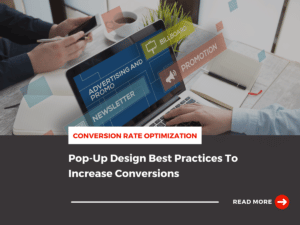Almost every website can benefit from a creative pop-up design with a powerful CTA and a purpose. These marketing tools allow brands to connect with website visitors and convert them into paying customers. However, you’ll need to take a strategic approach to your pop-ups and consider pop-up design best practices to ensure your content resonates with your audience. If you’re building out desktop and mobile pop-ups that aren’t seeing results, it’s time to take a step back and re-evaluate your approach.
Here’s a rundown of UX pop-up best practices and pop-up design UI tips you need to know:
Pop-Up Design Tips For Success
There is no one size fits all creative pop-up design that helps you increase conversions and see results. Every business, industry, and CTA is different. However, there are pop-up design best practices businesses can keep in mind when building mobile pop-ups that align with their goals and marketing strategy.
Here’s the rundown of UX pop-up best practices:
Pick Compliant Formats
You want to ensure the pop-ups don’t interfere with the site’s user experience and provide value, not friction. Here are a few UX pop-up best practices to ensure your pop-ups aren’t intrusive:
- Avoid pop-ups that take up the whole screen. They should never block the view of your website or take away from the shopper experience.
- Your mobile pop-ups should be optimized for mobile devices
- Consider bar pop-ups or slide-out options
- If you choose to go full screen, make sure it’s not until the consumer has scrolled at least half the page
- Play with timing, exit intent, or click to pop-up
If you see a sudden drastic change in your search engine rankings, you may want to re-evaluate the different types of pop-ups you have running on your website to ensure they aren’t interfering with your search rankings.
Segmentation and Personalization
Segmentation and personalization are two different approaches that can help you see results. These tools allow you to personalize the shopping experience based on the information you already have about the customer. Here are a few different ways you can segment your mobile pop-ups for your customers:
- New site visitors or new to file
- Returning customers who haven’t made a purchase
- Individuals that have abandoned their cart
- Loyal buyers
- Location-specific
- Visitors that come from social media or email
The more segmented your pop-ups are, the better the results. Don’t believe us? Abandoned cart pop-ups have a 17.2% conversion rate, while newsletter promotion pop-ups only see a 5.3% conversion rate.
Always Have a CTA
Every pop-up needs to have a call to action. CTAs are the driving force that pushes website visitors to take action. You’ll want to ensure your CTA aligns with your goals and marketing initiatives. If you don’t have a clear CTA, you’re less likely to see conversions, and shoppers will exit your pop-up and move on with their day.
Most pop-ups, especially on mobile devices, are small and less intrusive. You may need to re-evaluate your CTAs to complement the mobile experience.
Clear and Concise Word Choices
Too many words can leave your pop-up design cluttered and overwhelming for website visitors. Try your minimal words and phrases that are short and sweet. The fewer words, the better.
Aim to get your point across in as little as 5-10 words on the pop-up. You can always add more context in your email follow-up after the individual has already converted with the desktop or mobile pop-up.
Choose the Right Form Fields
If there are too many form fields to fill out, your website visitors are less likely to take the time to fill them out. Keep things simple, sleek, and productive.
If you’re a B2C business with the only goal to capture emails, only add an email field. If you’re a B2B looking for more viable leads, you may consider asking for their name and business. Your form fields should align with your overall goal and CTA for your pop-up.
As a general rule of thumb: The simpler, the better if you’re looking for more individuals to enter the sales funnel. If you’re looking for quality leads, don’t be afraid to add 2-3 form fields.
How to Boost Conversion Rate With Pop-Ups
Exit Intent Strategy
Exit intent technology tracks website visitors’ activity and knows when they’re getting ready to exit your website. The trigger is typically when a website visitor moves their mouse over the x button on the webpage. This technology allows marketers the last chance to persuade shoppers to take action. Mobile pop-ups with an exit intent strategy won’t disrupt the experience with your website, which means they’re more likely to lead to conversions.
Make Them Interactive
Consider testing the waters with a gamify-style pop-up. Pop-ups, where individuals need to spin to win a discount are an interactive way to keep customers engaged and coming for more. They’re also one of the most effective tools to keep your consumers engaged and convince them to come back to your website to shop.
Optimize Mobile Friendliness
Mobile friendliness is key to maintaining your site authority and providing the best mobile experience. You’ll want to choose formats that can easily be scaled down to the size of a mobile device. If your pop-ups are too intrusive or aren’t coming out the way you wanted them to, you can consider hiding them from mobile devices and only keeping them on the desktop view.
However, before you consider hiding them from mobile, it’s important to note that on average, mobile pop-ups convert 1.8 times more website visitors than desktop pop-ups.
Remove Images
Yes, the images look great. However, how much value do they add to the customer experience? Images tend to compete with your CTA and the goal of your pop-up. It’s always better to go with a clear and concise creative pop-up design than to rely on images. Instead of images, consider playing with different colors or design components that are eye-catching.
Start Creating Next-Level Mobile Pop-ups
Mobile pop-ups are an invaluable marketing tool that every business can capitalize on. At Kanbar Digital, we can help you fine-tune your mobile pop-up strategy to meet the needs of your business and your customers. Our team understands the ins and outs of UX pop-up best practices and is here to help you implement cutting-edge strategies on your site.
Connect with us today to learn more.




